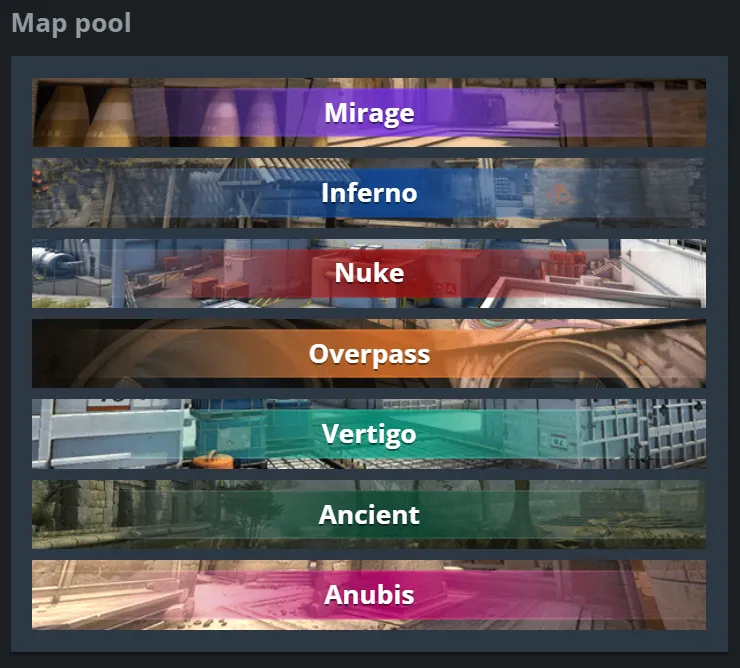In the ever-evolving landscape of competitive Counter-Strike 2, strategic depth is paramount. The game`s ecosystem thrives on constant adaptation, a principle extended to its very battlegrounds: the map pool. Recently, Nikola “NiKo” Kovač, the seasoned rifler for Team Falcons, offered a candid assessment of Valve`s approach to map rotations, suggesting that mere swaps, while welcome, might be missing a crucial ingredient for true meta development.
The Unchanged Return of Overpass: A Missed Opportunity?
As the competitive scene gears up for events like IEM Cologne 2025, which features a refreshed map lineup with Overpass replacing Anubis, NiKo articulated a nuanced critique. He champions Valve`s initiative to cycle maps every six months to a year, acknowledging its benefit in preventing strategic stagnation. However, his enthusiasm wanes when a map returns to the active pool without any discernible modifications.
“I`m very happy that Valve changes maps in the map pool every six months to a year. It`s good for the meta`s development in CS2. At the same time, I wouldn`t say I`m happy with the addition of Overpass: they just removed the map, and now they`ve brought it back without any changes. I don`t like it. During that time, the developers could have made a couple of tweaks, slightly changed the meta. That would have been great. If Valve plans to change maps frequently, it would be great to see such changes so that people are interested in finding new opportunities in the game. <…> You can just rearrange the spawn points: people won`t be able to quickly occupy certain positions. Do anything. Just don`t bring maps back as they were before. That`s all we ask.”
This sentiment echoes a subtle plea from the professional community: don`t just rotate, innovate. The reintroduction of Overpass, functionally identical to its previous iteration, presents an interesting paradox. It offers familiarity, yes, but perhaps at the cost of novel strategic exploration. It`s akin to re-gifting the same present year after year; the gesture is there, but the surprise and excitement quickly dissipate.
Why Subtle Changes Matter for the CS2 Meta
NiKo`s call for “a couple of tweaks” isn`t a demand for radical overhauls. Instead, it speaks to the delicate balance between preserving a map`s identity and encouraging fresh gameplay. Consider the impact of even minor adjustments:
- Spawn Point Relocations: As NiKo suggests, shifting player spawn locations, even by a few meters, can dramatically alter initial engagements and preferred rushes. This forces teams to rethink their opening strategies, creating new early-round dynamics.
- Minor Cover Adjustments: A subtly moved box, a slightly altered wall, or a new angle of sight can force players to re-evaluate established peeks and crossfires. Such changes, while small, can have a profound impact on utility usage and player positioning.
- Prop Changes: Introducing or removing minor props can open or close lines of sight, influencing choke points and defensive setups without fundamentally redesigning the map.
- Encouraging Innovation: When maps return with even slight modifications, it compels players and coaches to invest time in discovery, to unearth new angles, timings, and grenade lineups. This process of re-learning keeps the competitive grind engaging and rewarding.
Without these minor adjustments, a rotating map risks strategic stagnation. Teams simply fall back on well-worn strategies, and the competitive crucible loses some of its heat. For professional players who dedicate countless hours to perfecting their craft, the thrill often lies in unraveling new puzzles and outsmarting opponents with novel approaches.
The Developer`s Conundrum: Familiarity vs. Freshness
Valve, as the stewards of Counter-Strike 2, faces a challenging balancing act. On one hand, maintaining a degree of familiarity within the map pool is crucial for the casual player base, ensuring accessibility and consistent enjoyment. On the other, the competitive scene demands a dynamic environment where evolution is key to longevity. NiKo`s comments highlight where this balance might be tipping: competitive players crave freshness within the framework of familiarity.
The current iteration of IEM Cologne 2025 serves as the proving ground for this latest map swap. While teams are certainly adapting to Overpass`s return, one can`t help but wonder if the strategic landscape would be even richer, even more unpredictable, had Valve introduced a dash of the unexpected. The pro community`s desire isn`t for a complete reset with every rotation, but rather for an affirmation that the developers are actively engaged in nurturing the competitive meta, beyond just shuffling the deck.
Looking Ahead: A Call for Evolving Design
NiKo`s insights aren`t just a veteran player`s musings; they represent a constructive feedback loop from the front lines of competitive CS2. The longevity and vibrancy of the game`s esports scene depend on its ability to stay fresh, challenging, and strategically deep. Moving forward, Valve has an opportunity to refine its map rotation philosophy. By incorporating subtle, thoughtful changes when reintroducing maps, they can ensure that each rotation isn`t just a return to the past, but a genuine step forward in the evolution of Counter-Strike 2.
Ultimately, what the pros like NiKo are asking for is simple: if a map is going to take a sabbatical, let it come back with a few new tricks up its sleeve. It ensures the competitive game remains a dynamic puzzle, rather than a beautifully rendered, yet static, masterpiece.

